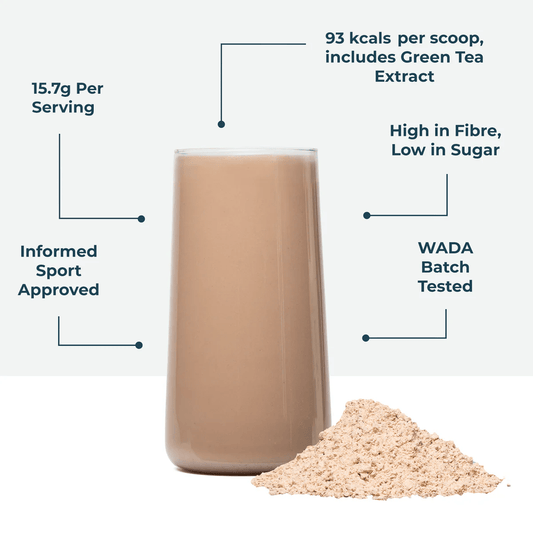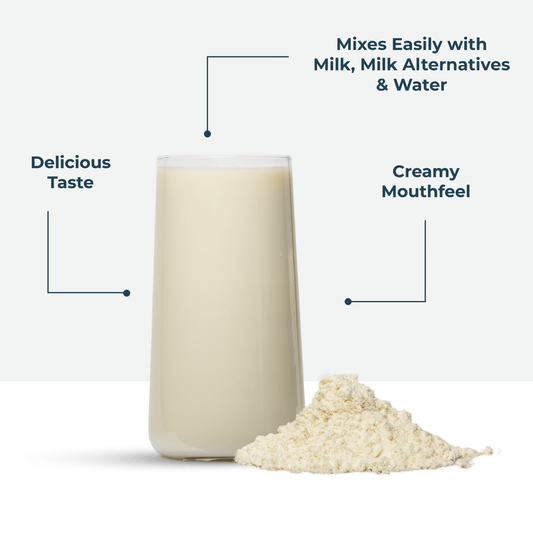Do Protein Shakes Help with Weight Loss:

If you’re on a mission to get in shape, you will undoubtedly have come across the idea that protein shakes can be a valuable nutritional addition to your diet. However, understanding how these can fit into the broader framework of your goals can be confusing.
Many people also search for simple protein shakes weight loss tips because they want to know if protein shakes truly support fat loss.
In this article, we’ll bring the facts together to help you understand the connections between protein shakes and weight loss. Some of the areas we’ll cover include:
- What is a protein shake?
- What is weight loss?
- Do protein shakes help you lose weight?
- Understanding protein shakes: FAQs
What is a protein shake?
To begin, we must define what a protein shake is.
A protein shake is a drink made by mixing protein powder with milk (dairy or plant-based), water, or another liquid such as coconut water. This can either be done at home, with a source of protein powder; or during manufacture, which is then sold as a pre-mixed protein drink.
There are many different types of protein powders and pre-mixed shakes on the market, with a variety of flavours and textures to choose from. Whatever your favourite, they each offer a concentrated source of protein made from various sources, such as whey, casein, soy, pea, hemp and rice.
Buy Now – Kinetica Sports Protein Supplements
What is weight loss?
Before we get into the details about protein shakes and weight loss, it’s also important to define what exactly we mean when we use the term.
When talking about weight loss, we all tend to focus on something more specific: fat loss. The majority of people, when they are considering weight loss, want to decrease the amount of fat (adipose tissue) in the body.
Typically, this fat loss happens by sustaining a calorie deficit diet; i.e. where you are eating fewer calories than you are expending. In this hypocaloric state, instead of using carbohydrates, fatty acids are mobilised from fat cells into the bloodstream, and broken down for energy production. This is called lipolysis.
And, what is the net result of burning more fatty acids for fuel? A smaller fat cell – which leads to us becoming leaner.
Note: while your fat cells release stored fatty acids, the number of fat cells tends to stay roughly the same.
This focus on fat loss when defining weight loss is worth knowing for a few reasons.
Firstly, it helps us understand what we mean by “losing weight”; it’s about getting leaner, not simply lighter. This helps to guide your training programme as well as your nutritional requirements.
It also helps to define throwaway terms like “toning up”, which are otherwise quite confusing. We don’t really “tone up” a muscle. Instead, toning is characterised by reduced fat stores within a muscle (intramuscular fat) and on top of a muscle (subcutaneous fat) to look leaner. This is a particularly important idea for bodybuilders, where “cutting” is a key stage involving reducing body fat without losing muscle mass to highlight muscle shape.
Secondly, focusing on fat loss puts more of a focus on energy balance. With a regular, non-deficit, diet, the majority of your energy comes from the breakdown of carbohydrates into glucose; which is then used in cellular respiration. However, if you want to lose fat, then a sustained calorie deficit encourages the body to burn calories from stored sources.
Third, refining the term weight loss down to a more accurate lens of body composition also puts our attention toward maintaining (or increasing) muscle mass. With weight loss, you usually want to burn off excess fat but keep overall muscle.
Why? There are heaps of reasons, including but not limited to:
- Increased lean muscle mass helps to boost our resting metabolic rate (the amount of calories our body uses at rest).1,2
- Muscle is not just for movement; it is an endocrine organ (organs that release hormones) with many positive roles in our health3.
- As we age, loss of muscle (sarcopenia) has wide-ranging and negative effects on our wellbeing4.
In short, when we talk about “weight loss”, we really need to focus on fat loss and preserving lean muscle. Combining both can make an enormous difference to our health, body shape and longevity.
With this however, comes the question of nutrition. Understanding how your diet can maximise your weight loss goals is incredibly important – and where protein shakes, and weight loss, coincide.
Do protein shakes help you lose weight?
As you know, our diet has three primary macronutrients – protein, carbohydrates and dietary fats. Out of these three, protein is a top priority. Indeed, protein comes from the Greek word prōteios, meaning “primary” or “of first rank”.
The human body requires a certain amount of protein each day because of the amino acids they contain. Amino acids provide the building blocks for many aspects of our physiology – muscle, hair, skin, nails, organs, and hormones. Protein also plays a wide variety of roles in our health, including keeping our immune systems strong5,6.
Within various proteins, there are 20 amino acids – 9 of which are deemed essential. This doesn’t necessarily make them more important, but they’re essential because the human body cannot make these amino acids endogenously. Instead, the body must consume them – predominantly from protein-rich foods, and supplementation, on a regular basis to maintain our health and wellbeing7.
But what does this mean for protein shakes and weight loss? Well, from a fat loss perspective, prioritising protein helps in a variety of ways:
- Satiety: protein is known to be more satiating than carbohydrates or fats. This means that consuming protein can help you feel fuller for longer, potentially leading to reduced overall calorie intake8.
- Thermic Effect of Food (TEF): Protein has a higher TEF than fats and carbohydrates. This means your body burns more calories digesting and metabolising protein than other macronutrients. The thermic effect of protein (25-30%) is higher compared to carbohydrate (6-8%) and dietary fat (2-3%)9. TEF can be pretty important in the grand scheme of fat loss, accounting for 8-15% of total daily calorie expenditure10.
- Muscle preservation: From a muscle retention perspective, consuming sufficient protein each day is also vital. When trying to lose weight, primarily through calorie restriction, there's a risk of losing muscle mass. Consuming adequate protein can help preserve muscle mass when dieting, especially during regular resistance training11,12. As you get leaner, protein intake becomes even more critical when in a calorie deficit to sustain the muscle you have.
- Increased metabolism: Muscle is metabolically active, which means it burns calories even when at rest. By preserving or building muscle through protein intake and resistance training, you can support resting metabolic rate and boost insulin sensitivity4. Insulin is the primary hormone for regulating blood glucose, and resistance training helps to increase GLUT4 function – and your ability to handle carbohydrates13.
Once your protein intake is dialled into the needed levels, you can customise fat and carbohydrate intake to suit your preferences and match your activity levels. This point is essential. Research shows that no single diet works best for all people10. There are various ways to achieve sustained calorie deficits to get leaner, and each type of diet has pros and cons. The key is to find the approach that works for you and keep protein as a priority as a starting point14.
The best protein shakes for weight loss then, have a high percentage of protein to help you feel fuller for longer, and provide your body with essential building blocks to boost your lean muscle mass. Whether you make your protein shakes at home, or purchase them pre-mixed, always look for high-quality ingredients and protein sources to help you meet your goals.
Understanding protein shakes: FAQs
Now that we’ve explored how protein can help weight loss, what about some more practical advice. In our FAQ section, we’ve picked out some of the most common questions on protein shakes (and their weight loss benefits) to give you the information you need to make the best choices.
What are the advantages of pre-mixed protein shakes?
We’ve touched on it previously, but there are a range of options for getting additional protein into your diet; from upping the protein content of your meals, to using protein powder supplements to support your diet. It’s the latter category where there is even more choice – namely, pre-mixed protein shakes.
But what are some of the advantages of buying your protein shakes readymade?
- Convenient: the primary purpose of a protein shake is to provide the body with a quick and convenient source of protein. Kinetica High Protein Milkshake are completely ready to go – just grab, shake, and drink. Easy peasy, right?
- Consistent: premium pre-mixed protein shakes are incredibly consistent. You know exactly what is in them and how much protein you’re getting – without having to think about it. Perfect for portion control, or busy lifestyles when you’re constantly on the go.
- Delicious: the best protein shakes (for weight loss or otherwise) are tried and tested until the flavour is just right.
Need an example? Here at Kinetica Sports, we have a superb collection of Ready-Made Protein Shakes for you to choose from in three delicious flavours! With a fantastic 25g of high-quality protein per bottle, our protein shakes could be a valuable element of your weight loss routine. They’re also Informed Sport certified, so you can trust that there’s no hidden surprises or banned substances – perfect for athletes and weekend warriors alike.
Who should be having whey protein shakes?
There are many different sources of protein for supplements – in shakes or as a powder – and whey is one of the most popular. Research has consistently shown that whey can help with fat loss in the gym and doing resistance training whilst in a hypocaloric state15,16.
In this way, whey protein can be helpful for many different types of people:
- Athletes and fitness enthusiasts: those who engage in regular workouts, especially resistance training, can benefit from whey protein to support muscle recovery and growth. Protein shakes are a convenient way to incorporate additional protein, and can be taken into the gym or to the field with ease.
- Fat loss seekers: As we’ve mentioned throughout, protein can aid in fat loss, and whey provides a convenient source used in premium protein shakes for weight loss.
- Vegetarians, or those with protein-deficient diets: while whey is not suitable for vegans (since it's derived from milk), vegetarians might find it a beneficial supplement to ensure they get enough protein in their diets.
- Busy people: many people do not have time to prepare fresh meals with additional high-quality protein; therefore, whey can be a valuable option to have on hand to supplement your daily protein needs.
Learn more about choosing the best option with our Whey Protein Buying Guide…
How much protein do you need?
When the goal is fat loss, and you are in a sustained caloric deficit, taking on protein above the RDA level of 0.8g/kg/day is essential to consider12.
For example, suppose you are an athlete training consistently and looking to lose body fat. In that case, your protein intake might require anything between 1.6-2.4g/kg/day, depending on the severity of calorie deficit, the type of training, and your sports-performance needs17.
When is the best time to take a protein shake?
There has been a lot of research into nutrient timing14. The biggest priority for protein is ensuring you take on enough over 24 hours. In this sense, timing is less important than hitting your protein numbers; by eating protein at each meal and supplementing as needed.
If you want to look at timing, there are specific moments when it might be beneficial to take on protein:
- Breakfast: including protein in your morning meal can help you feel full and provide sustained energy and focus throughout the day18.
- Post-workout: after a workout, your muscles are primed to absorb nutrients. Consuming protein soon after training can support muscle recovery and anabolism, helping you maintain muscle mass19.
Is it possible to gain mass whilst also losing body fat?
Yes. This is often called “body recomposition”20. However, anabolic signalling is not at its greatest because you are focused on a net calorie deficit to lose body fat. This can blunt some people’s best efforts at muscle hypertrophy.
Or, to put it more simply, sometimes in a calorie deficit it can be harder to increase your lean muscle mass. In this scenario, protein remains a priority with body recomposition efforts to help maintain both fat loss and muscle growth.
Achieve your fitness goals with support from Kinetica Sports
While the focus of this blog article was to understand the potential connection between protein shakes and weight loss, it’s important to remember that how we turn up each and every day trumps everything. Knowing why you train, and what your goals are is one of the most important parts of fitness. Body composition is only one piece of a larger puzzle – taking account of your energy levels, happiness and overall wellbeing is so important and is not to be underestimated.
But, when you do want to look at nutritional support, we’re here for you. Kinetica Sports’ whey and plant-based protein powders and protein shakes are high-quality, WADA-compliant and certified through Informed-Sport, giving you peace of mind about the content of what you are consuming.
Don’t forget to check out the Kinetica Sports blog for more insights, buying guides, and nutritional information.
We think you’ll also like… Everything You Need to Know About Diet Protein | An Introduction to Workout Supplements | Are Mass Gainer & Protein Powder The Same?










